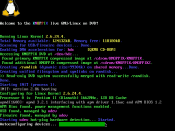Boot process is the time between a person turned on the computer and the time the computer is ready to be used. Boot process runs very smoothly in Windows computers, but if there was a problem, it needs to be repaired before any software is open. As the power-on self-test is operating, the boot process produces flashing lights, whirring noises, and beeping. This test gives you a warning if the computer is out of whack, but it's unable to warn you of what's about to happen. The most important purpose of the boot process is that it loads the operating system from hard disk into memory, which communicates with any input, output, or storage devices. The reason that the operating system can't stay in the memory permanently is that most of the computer's memory is RAM, therefore the memory is erased when the computer is turned off. Besides RAM, there are also ROM and CMOS that can hold memory even when the computer is off but they are too small to carry the whole operating system.
There are six steps during the boot process, which include power up, start boot program, power-on self-test (POST), identify peripheral devices, load operating system, and check configuration and customization. Power up involves power from a wall outlet to turn on a small power light. The POST let you know of a failure in your computer by displaying an error message, which allows you to know exactly what went wrong on your computer. If your monitor couldn't open its screen, there will be different beep codes letting you know of what's going on. By fixing the problem that the POST is notifying you, you should first turn off the computer. Then wait for about 5 seconds after the computer has totally shut down, turn...


